Asymptotically Convergent Higher-Order Switching Differentiator
Abstract
:1. Introduction
- The proposed HOSD can estimate higher-order time-derivatives of a time-varying signal. Estimation errors are proved to approach zero asymptotically irrespective of large initial errors.
- The HOSD estimations show no peaking or chattering, although its dynamics contain switching functions.
- The dynamic equations and structure of the differentiator are relatively simple compared with those of other well-known derivative estimators.
2. Main Results
2.1. Preliminaries
- 1.
- V(t) exists.
- 2.
- is twice differentiable on each interval .
- 3.
- exists, such that .
2.2. Expansion to the Second-Order Differentiator
2.3. Expansion to HOSD
- holds
- for holds under the assumptions of for .
3. Simulation
3.1. Example 1
3.2. Example 2
- Construct a differentiator that can estimate up to second time-derivatives of a signal , which is defined in the next step. Let and be the estimate of and , respectively, in what follows.
- The signal is composed using the following control input filtering:where is a design constant usually chosen as 1, and is the tracking error.
3.2.1. First Simulation
3.2.2. Second Simulation
4. Conclusions
Author Contributions
Funding
Conflicts of Interest
References
- Han, J. From PID to Active Disturbance Control. IEEE Trans. Ind. Electron. 2009, 56, 900–906. [Google Scholar] [CrossRef]
- Belanger, P.R.; Dobrovolny, P.; Helmy, A.; Zhang, X. Estimation of Angular Velocity and Acceleration from Shaft-Encoder Measurements. Int. J. Robot. Res. 1998, 17, 1225–1233. [Google Scholar] [CrossRef] [Green Version]
- Khalil, H.K. High-Gain Observers in Feedback Control: Application to Permanent Magnet Synchronous Motors. IEEE Control Syst. Mag. 2017, 37, 25–41. [Google Scholar]
- Levant, A. Non-homogeneous finite-time-convergent differentiator. In Proceedings of the 48th IEEE Conference on Decision and Control, Shanghai, China, 15–18 December 2009; pp. 8399–8404. [Google Scholar]
- Carneiro, J.F.; Almeida, F.G.D. On the Influence of Velocity and Acceleration Estimators on a Servopneumatic System Behaviour. IEEE Access 2016, 4, 6541–6553. [Google Scholar] [CrossRef]
- Gao, Z. Active Disturbance Rejection Control: A Paradigm Shift in Feedback Control Design. In Proceedings of the 2006 American Control Conference, Minneapolis, MN, USA, 14–16 June 2006. [Google Scholar]
- Efimov, D.; Zolghadri, A.; Raissi, T. Actuator fault detection and compensation under feedback control. Automatica 2011, 47, 1699–1705. [Google Scholar] [CrossRef]
- Park, J.-H.; Kim, S.-H.; Park, T.-S. Output-Feedback Adaptive Neural Controller for Uncertain Pure-Feedback Nonlinear Systems Using a High-Order Sliding Mode Observer. IEEE Trans. Neural Netw. Learn. Syst. 2019, 5, 1596–1601. [Google Scholar] [CrossRef] [PubMed]
- Park, J.-H.; Kim, S.-H.; Park, T.-S. Approximation-Free Output-Feedback Non-Backstepping Controller for Uncertain SISO Nonautonomous Nonlinear Pure-Feedback Systems. Mathematics 2019, 7, 456. [Google Scholar] [CrossRef] [Green Version]
- Park, J.-H.; Kim, S.-H.; Park, T.-S. Approximation-Free State-Feedback Backstepping Controller for Uncertain Pure-Feedback Nonautonomous Nonlinear Systems Based on Time-Derivative Estimator. IEEE Access 2019, 7, 126634–126641. [Google Scholar] [CrossRef]
- Levant, A. Robust Exact Differentiation via Sliding Mode Technique. Automatica 1998, 34, 379–384. [Google Scholar] [CrossRef]
- Levant, A. Universal Single-Input–Single-Output (SISO) Sliding-Mode Controllers with Finite-Time Convergence. IEEE Trans. Autom. Control 2001, 46, 1147–1451. [Google Scholar] [CrossRef] [Green Version]
- Levant, A. Higher-order sliding modes, differentiation and output-feedback control. Int. J. Control 2003, 76, 924–941. [Google Scholar] [CrossRef]
- Wang, X.; Chen, Z.; Yang, G. Finite-Time-Convergent Differentiator Based on Singular Perturbation Technique. IEEE Trans. Autom. Control 2007, 52, 1731–1737. [Google Scholar] [CrossRef]
- Ibrir, S. Linear time-derivative trackers. Automatica 2004, 40, 397–405. [Google Scholar] [CrossRef]
- Khalil, H.K. Cascade high-gain observers in output feedback control. Automatica 2017, 80, 110–118. [Google Scholar] [CrossRef] [Green Version]
- Angulo, M.T.; Moreno, J.A.; Fridman, L. Robust exact uniformly convergent arbitrary order differentiator. Automatica 2013, 49, 2489–2495. [Google Scholar] [CrossRef]
- Shao, X.; Liu, J.; Li, J.; Cao, H.; Shen, C.; Zhang, X. Augmented nonlinear differentiator design and application to nonlinear uncertain systems. ISA Trans. 2017, 67, 30–46. [Google Scholar] [CrossRef]
- Park, J.-H.; Kim, S.-H.; Park, T.-S. Asymptotically convergent switching differentiator. Int. J. Adapt. Control Signal Process. 2019, 33, 557–566. [Google Scholar] [CrossRef]
- Su, Y.; Huang, J. Stability of a Class of Linear Switching Systems with Application to Two Consensus Problems. IEEE Trans. Autom. Control 2012, 57, 1420–1430. [Google Scholar] [CrossRef]
- Hunter, J.D. Matplotlib: A 2D graphics environment. Comput. Sci. Eng. 2007, 9, 90–95. [Google Scholar] [CrossRef]
- Park, J.-H.; Kim, S.-H.; Park, T.-S. Approximation-Free Output-Feedback Control of Uncertain Nonlinear Systems Using Higher-Order Sliding Mode Observer. J. Dyn. Syst. Meas. Control 2018, 140, 124502-1–124502-5. [Google Scholar] [CrossRef]
- Park, J.-H.; Huh, S.-H.; Kim, S.-H.; Seo, S.-J.; Park, G.-T. Direct Adaptive Controller for Nonaffine Nonlinear Systems Using Self-Structuring Neural Networks. IEEE Trans. Neural Netw. 2005, 16, 414–422. [Google Scholar] [CrossRef]
- Park, J.-H.; Kim, S.-H.; Moon, C.-J. Adaptive Neural Control for Strict-Feedback Nonlinear Systems without Backstepping. IEEE Trans. Neural Netw. 2009, 20, 1204–1209. [Google Scholar] [CrossRef]
- Park, J.-H.; Park, G.-T.; Kim, S.-H.; Moon, C.-J. Direct Adaptive Self-Structuring Fuzzy Controller for Nonaffine Nonlinear Systems. Fuzzy Sets Syst. 2005, 153, 429–445. [Google Scholar] [CrossRef]
- Park, J.-H.; Park, G.-T.; Kim, S.-H.; Moon, C.-J. Output-feedback control of uncertain nonlinear systems using a self-structuring adaptive fuzzy observer. Fuzzy Sets Syst. 2005, 151, 21–42. [Google Scholar] [CrossRef]
- Park, J.-H.; Kim, S.-H. Direct Adaptive Output-Feedback Fuzzy Controller for Nonaffine Nonlinear System. IEE Proc. Control Theory Appl. 2004, 151, 65–72. [Google Scholar] [CrossRef]
- Park, J.-H.; Park, G.-T. Robust Adaptive Fuzzy Controller for Nonaffine Nonlinear Systems with Dynamic Rule Activation. Int. J. Robust Nonlinear Control 2003, 13, 117–139. [Google Scholar] [CrossRef]
- Park, J.-H.; Park, G.-T. Robust adaptive fuzzy controller for nonlinear system using estimation of bounds for approximation errors. Fuzzy Sets Syst. 2003, 133, 19–36. [Google Scholar] [CrossRef]




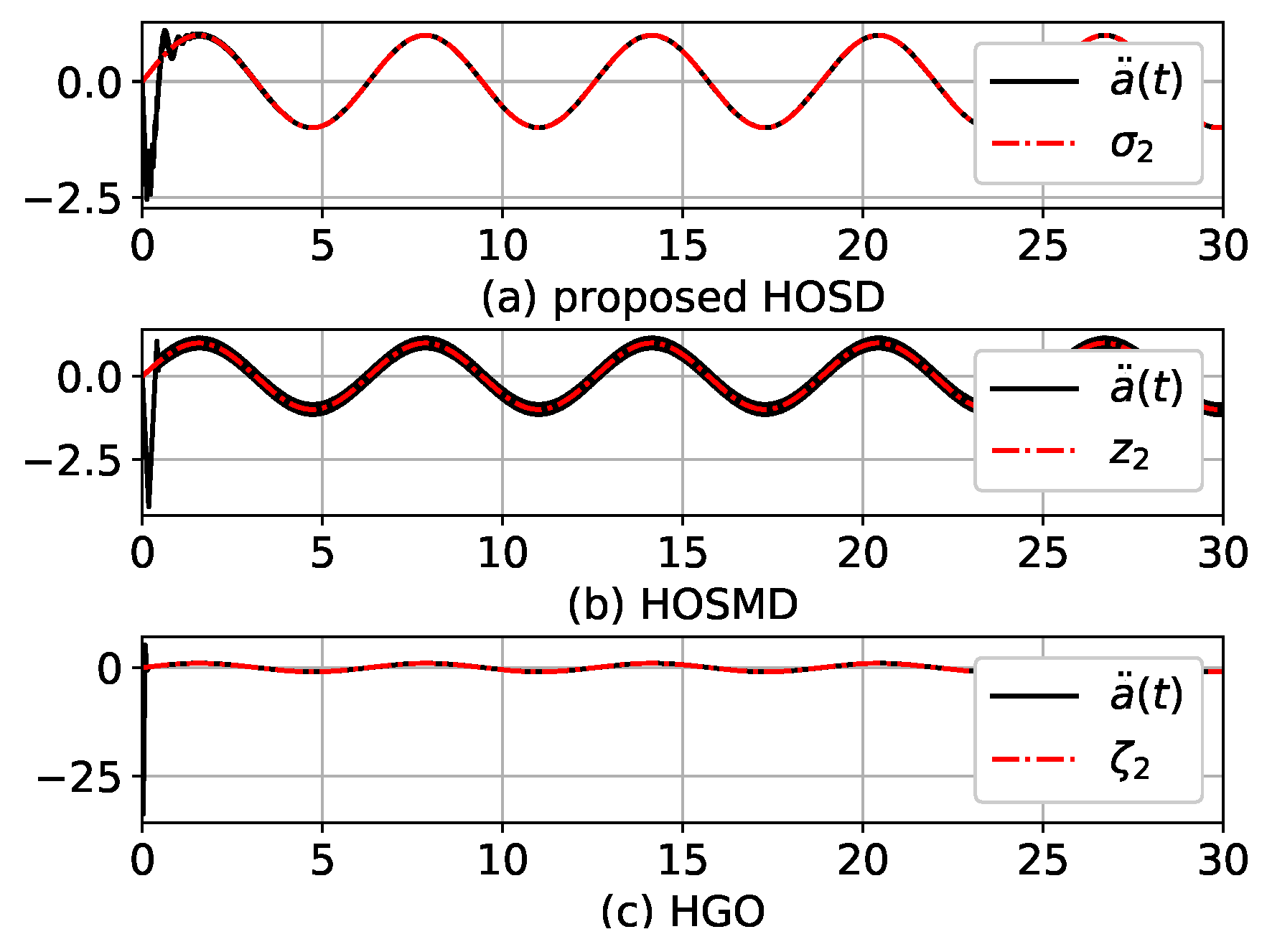


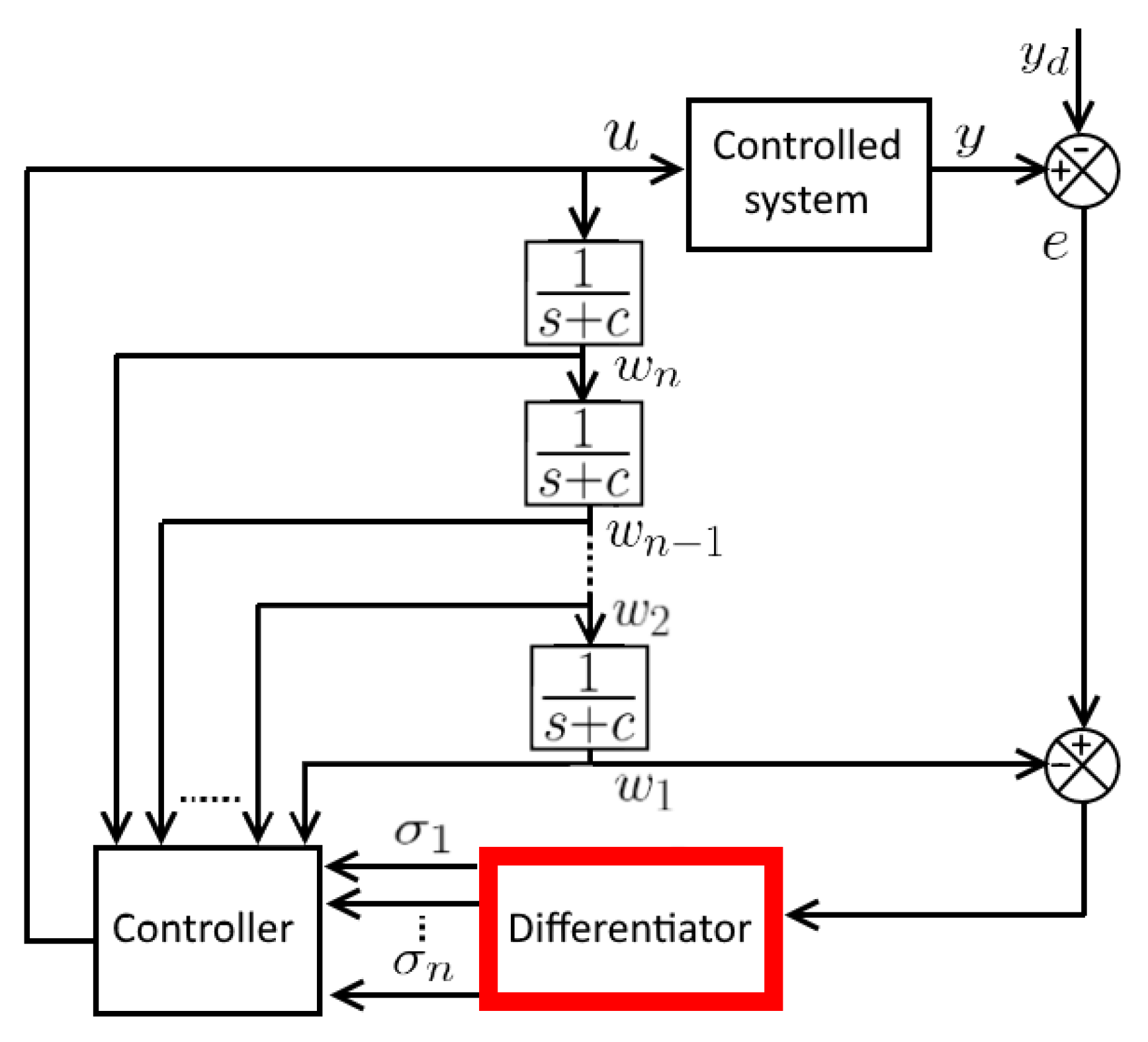
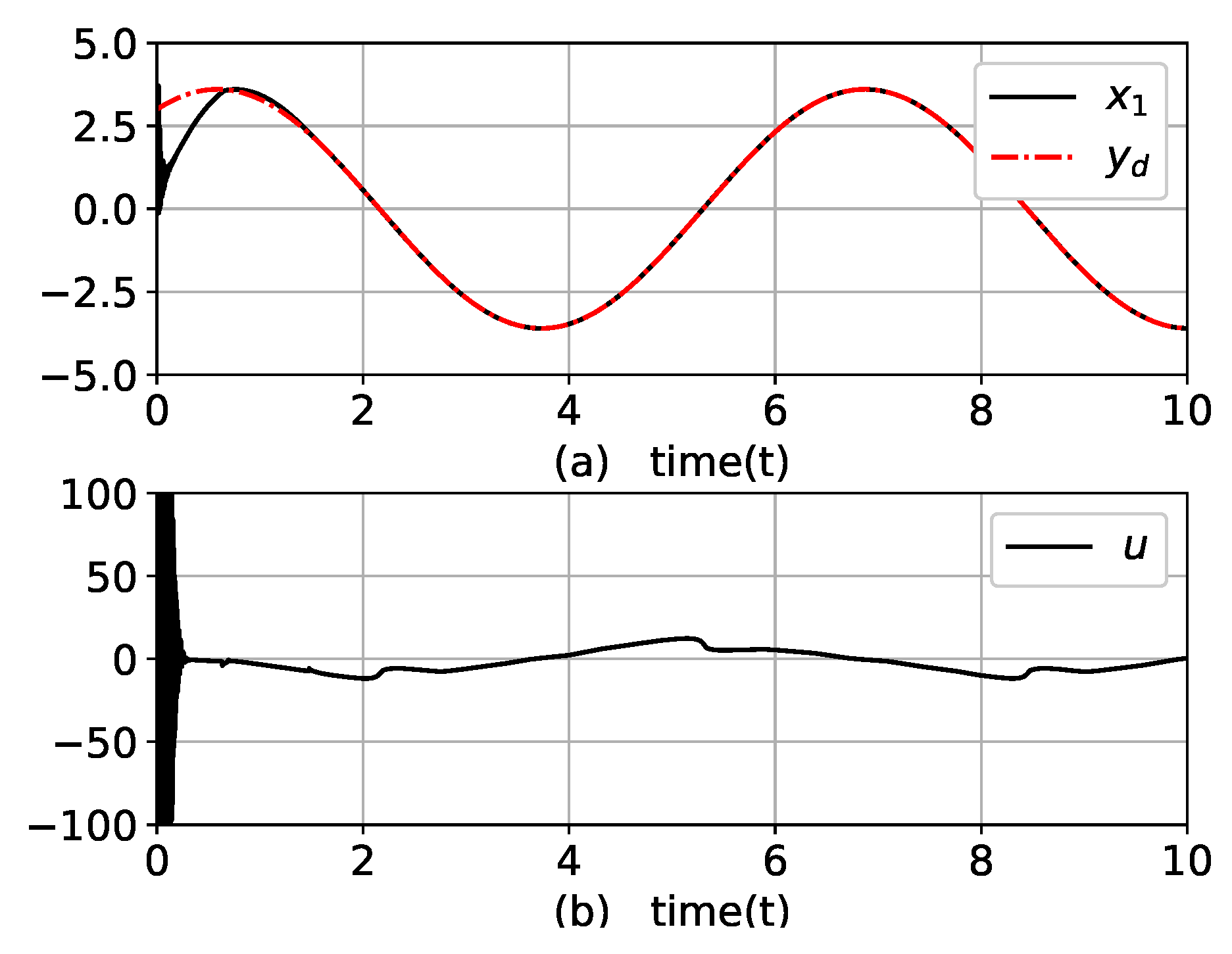

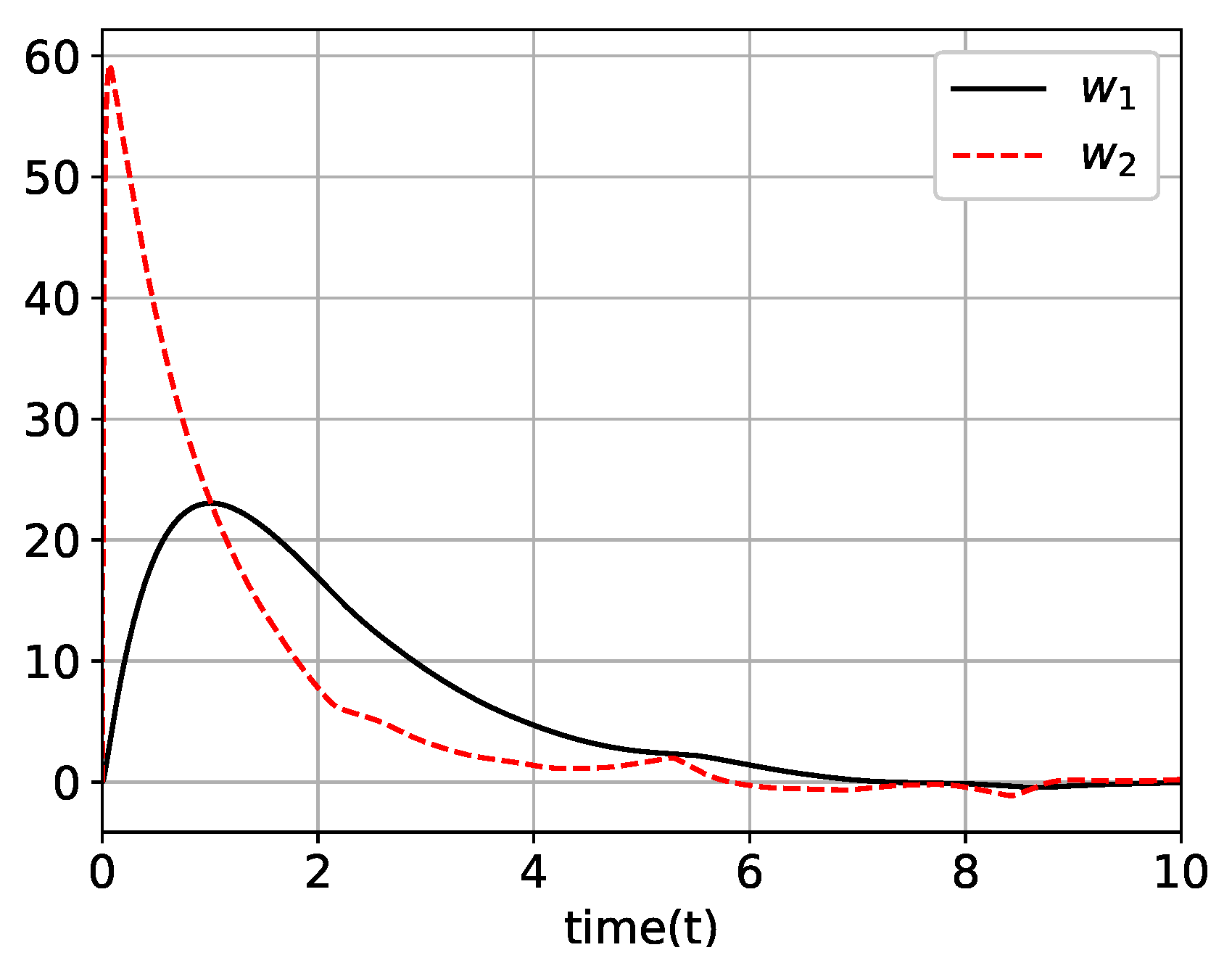

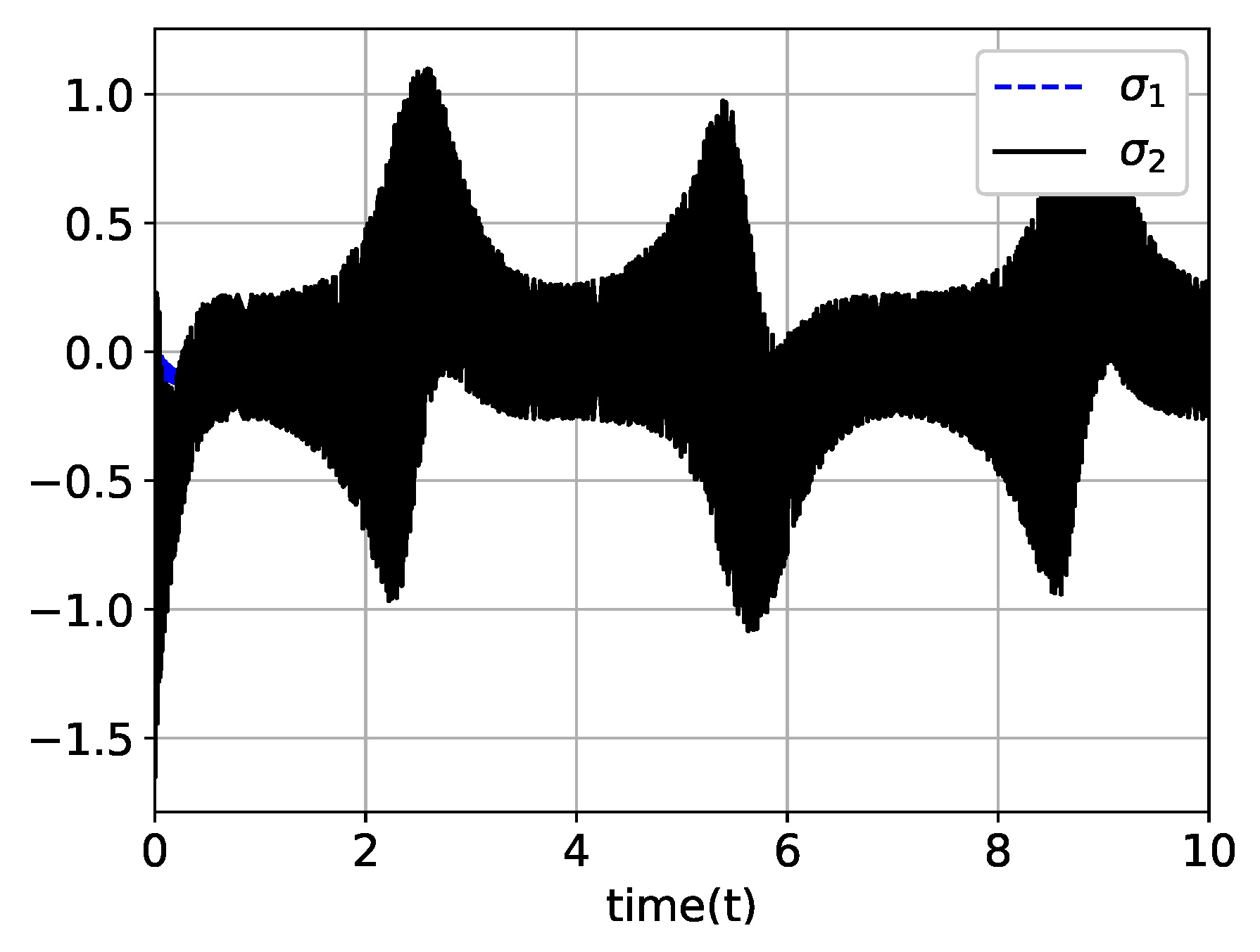










| HOSD | HOSDM | HGO | |
|---|---|---|---|
| ① | , | ||
| , | |||
| ② | , | ||
| , | |||
| ③ | , | ||
| , |
| HOSD | HOSDM | HGO | |
|---|---|---|---|
| controller constants: , | |||
| ⓐ | , | ||
| , | |||
| ⓑ | , | ||
| , | |||
© 2020 by the authors. Licensee MDPI, Basel, Switzerland. This article is an open access article distributed under the terms and conditions of the Creative Commons Attribution (CC BY) license (http://creativecommons.org/licenses/by/4.0/).
Share and Cite
Park, J.-H.; Park, T.-S.; Kim, S.-H. Asymptotically Convergent Higher-Order Switching Differentiator. Mathematics 2020, 8, 185. https://doi.org/10.3390/math8020185
Park J-H, Park T-S, Kim S-H. Asymptotically Convergent Higher-Order Switching Differentiator. Mathematics. 2020; 8(2):185. https://doi.org/10.3390/math8020185
Chicago/Turabian StylePark, Jang-Hyun, Tae-Sik Park, and Seong-Hwan Kim. 2020. "Asymptotically Convergent Higher-Order Switching Differentiator" Mathematics 8, no. 2: 185. https://doi.org/10.3390/math8020185





